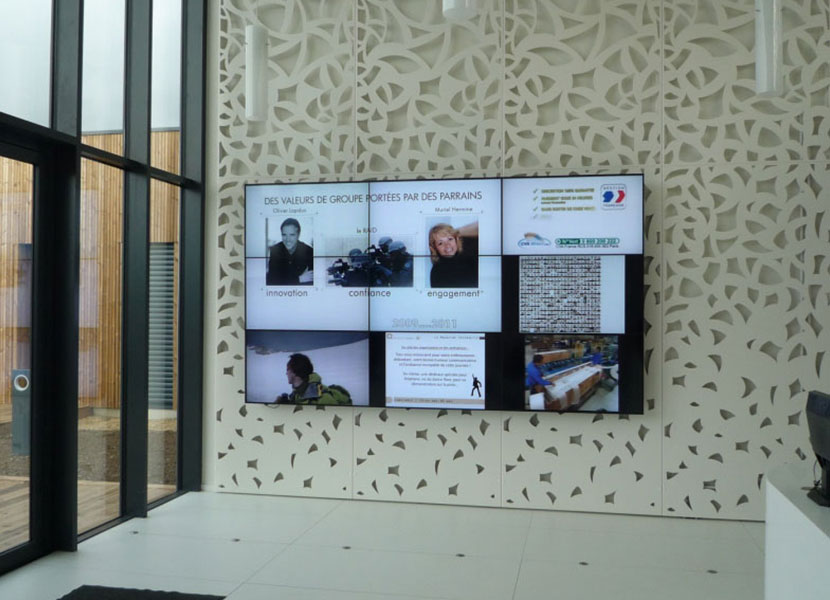Installing dynamic screens – mistakes to avoid

Dynamic screens are widely used as communication tools in the urban landscape and in establishments open to the public. Efficient and easy to install, they offer many advantages and can be used in a number of areas.
That said, there are a number of pitfalls to be avoided if you want to optimise your investment and maximise the effectiveness of dynamic screens.
Discover the mistakes to avoid when installing dynamic screens in this article!
Forgetting to think strategy when installing dynamic screens
- Dynamic screens are communication levers. Their main purpose is to broadcast static, animated or video content to audiences in the vicinity of the display. These are tools that companies use to transmit messages to a large number of people. The aim is to achieve image and brand awareness objectives as part of an overall communications strategy.
- Among the mistakes to avoid, companies are advised not to install dynamic screens without having fully thought through the reasons why they are choosing this type of communication tool. Companies that think in terms of strategy should study the ins and outs of installing dynamic screens. Who are the audiences they want to reach? What kind of messages do they want to get across? Is it a good idea to give dynamic screens other roles, such as sales support or optimising people flow? etc.
- As a general rule, a company has already determined its strategic direction when it decides to install dynamic screens. The success of the approach then depends on identifying the type of display solution that best enables it to be inspired, in order to maximise the potential of its communication actions.
Choosing the wrong equipment
Manufacturers of dynamic screens
They have made major innovations in LED technology. Digital displays have become commonplace, because they are more affordable and can be installed in a wide range of locations, both indoors and out. However, technological advances in dynamic displays have also led to a segmentation of display solutions, with categories of tools specialised in carrying out a task or designed for a specific context of use.
Businesses
Today’s businesses have a wide choice of digital signage solutions. Advertising panels, digital totems, kiosks… Each product category has its own particular features: dynamic screens can be adapted according to their functions and technical characteristics, and not all are equally suited to a company’s needs.
Screen pitch
Another technical characteristic of the screen resolution is decisive: the screen pitch. This is the distance between the centre of each pixel. The pitch is therefore an indicator of the pixel density of a screen: the finer it is, the sharper the image. It can also be used to determine the optimum viewing distance. The pitch of a screen, for example, is one of the many criteria to take into account when choosing an advertising LED panel!

Underestimating the power of digital technology
- Unlike traditional poster displays, dynamic screens offer companies greater freedom and agility in their communication activities. This is one of the main differences between dynamic and traditional displays. Content can be changed instantly, on a single screen or across an entire site. This gives companies the opportunity to create highly personalised communication campaigns that can be managed in real time. What’s more, thanks to their digital properties, dynamic screens make it easier to measure the effectiveness of messages transmitted.
- Digital signage content can be animated or video. This represents a real strength for the medium. The human eye is naturally attracted to movement. This medium therefore excels at capturing the public’s attention, and helps to increase the rate at which messages are remembered.
- Finally, the technical characteristics of dynamic screens give them a more important role than simply transmitting messages. When they are interactive in particular, they can improve customer knowledge by capturing data. But they can also help to increase sales in a shop, simplify the management of the flow of people in an establishment. Or enable visitors to be more autonomous in meeting their needs (for example, with self-registration in medical analysis laboratories), etc.
- The digital nature of dynamic screens gives them a potential that companies would be wrong to ignore. By understanding this potential, they can exploit it more effectively and optimise their investment as part of an ROI strategy.
Do not study the location of dynamic screens
Choosing a digital signage system is about more than just selecting a display solution. Companies can maximise the impact of their communications by considering their location.
The contexts in which audiences come into contact with an advertisement influence the impact of that advertisement on the audience. The availability of individuals varies according to their current activity when they “come across” a display. A company therefore needs to adapt the content it broadcasts according to the location of the screens. In this way, the message codes transmitted are appropriate to the display situations, under the watchful eye of the most effective advertisers. In other words, they effectively capture the attention of audiences wherever the screen is installed. This could be a bus stop, the roadside, the front of a building, a shop window, the entrance to an establishment, in a waiting room, or on the walls of a shop.
Neglecting technical support needs

In order to avoid errors, a company’s dynamic screens are technological tools managed by one or more people. It is essential that users take full ownership of the system so that it can be used to best effect.
The choice of dynamic displays is therefore accompanied by a study of the technical support offered by the manufacturer. Managing a fleet of digital displays requires training and effective after-sales service in the event of a malfunction. The manufacturer’s support services are an important criterion when choosing a digital signage system. They save time, energy and money!
Do not involve the head of an establishment
Companies interested in installing dynamic screens often have several sites. They can choose the tool best suited to the needs of the overall organisation. But the people on site can provide useful information for selecting a display solution.
The people in charge of a store and the sales teams have a vision of what’s happening on the ground. They are in daily contact with the public, know the opening hours and can help to determine the best locations. In particular, those that are likely to attract the attention of prospects and customers. By involving them in the choice of dynamic screens, companies can increase the effectiveness of their future advertising.
Failure to inform yourself about the regulations
The installation of a dynamic screen is subject to certain legal constraints. Companies are advised to familiarise themselves with a number of useful regulations before taking the plunge. These are mainly based on the size of the town and the screen, the display location and the context of use.
Dynamic screens offer companies a wide range of communication - and sometimes operational - possibilities. They are particularly effective thanks to their animated and video content. But to maximise their contribution to achieving image and brand awareness objectives, companies need to think strategically. The choice of dynamic displays is based on concerns such as: adapting messages, personalising them, studying the location, etc. This is how companies determine the appropriate type of dynamic display from among all those available: LED advertising panels, interactive totems, kiosks, etc.
In the same
categorie

10 tips for choosing, installing and using your digital signage system

Dynamic screen – the ally of your marketing strategy
